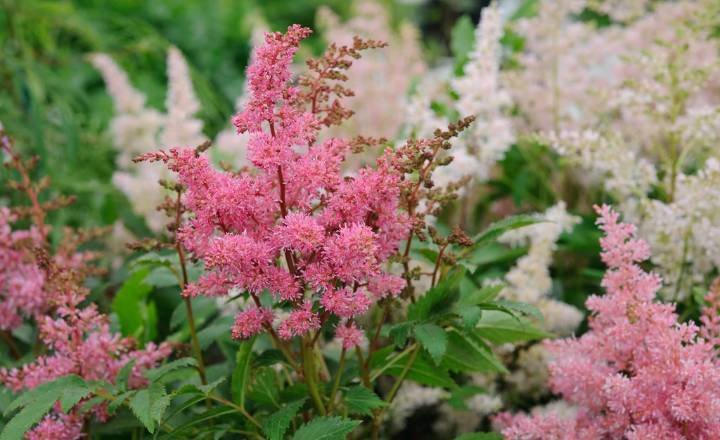In the gardening world, few plants can boast the vibrant elegance and lush texture that the Astilbe plant brings to shaded corners and damp gardens. Picture this: feathery plumes of pink astilbe, white, or red dance gracefully above a sea of glossy green foliage, creating a breathtaking display that rivals even the most extravagant floral arrangements.
Whether you’re an experienced gardener looking to elevate your shade garden or a novice seeking low-maintenance beauty, the Astilbe plant is truly captivating. Native to Asia and North America, this botanical gem thrives in environments where many other plants falter. With their ability to flourish in partial shade and their remarkable adaptability to varying soil conditions, astilbes enhance visual appeal and play an essential role in supporting local ecosystems.
How to Grow Astilbes
Astilbes are the perfect choice for gardeners looking to add drama and vibrant color to shaded areas. To grow these exquisite plants, begin by selecting a location that offers partial to full shade, as direct sunlight can scorch their lush foliage. Opt for well-draining soil rich in organic matter; incorporating compost or peat moss will enhance moisture retention, which is crucial for astilbes’ thriving roots.

Watering is essential during their initial growth phase and especially during dry spells in summer. Mulching around the base not only retains soil moisture but also suppresses weeds and keeps temperatures steady—perfect for those tender roots. Watch out for common pests such as aphids; deploying natural solutions like insecticidal soap can keep your astilbe plants healthy without resorting to harsh chemicals.
By adhering to these simple yet effective practices, you can unlock the stunning potential of this beloved perennial, transforming your garden into a vibrant tapestry of colors all season long.
Where to Grow Astilbes
Astilbe flowers thrive in locations that offer a harmonious balance of shade and moisture, making them ideal for woodland gardens or shaded corners in your yard. They truly shine under the canopy of deciduous trees where dappled sunlight filters through the leaves, providing just enough brightness without scorching their delicate foliage.
Remember to consider soil quality as well; astilbes prefer rich, well-drained organic matter that retains moisture but doesn’t become waterlogged. Beyond traditional garden beds, you can also use astilbes to enhance pond edges or moist border areas where they can flourish in wet conditions.
Pairing them with ferns or hostas can create a lush and inviting space while allowing their vibrant flower plumes to stand out during summer months. Another creative avenue is planting them in container gardens with consistent watering; this allows for versatile designs on patios or balconies while still enjoying their striking blooms and feathery texture. With thoughtful placement, astilbes not only beautify your landscape but also support local pollinators attracted by their blossoms.
Astilbe Care And Maintenance
Astilbe plants thrive in moist, shaded environments, making them perfect for brightening up those tricky spots in your garden where other blooms struggle. To maximize their lush foliage and striking flower plumes, ensuring the right soil condition is crucial.
They prefer rich, loamy soil with high organic content to retain moisture without becoming waterlogged. Regular mulching not only helps maintain soil temperature but also conserves moisture—making the routine less burdensome during dry spells.

When it comes to watering, consistency is key; Astilbes need regular hydration but be cautious of overwatering as they dislike sitting in soggy conditions. About once a month during peak growing seasons, consider supplementing their diet with a balanced fertilizer to encourage vibrant blooms and robust leaf growth.
Astilbe Varieties
Astilbe plants are often celebrated for their ornamental beauty and versatility in garden design. With an array of varieties available, ranging from the petite ‘Delft Lace’ to the towering ‘Montgomery,’ these lush perennials offer something for every landscape. Their vibrant plumes bloom from late spring to early summer, creating a stunning contrast against rich green foliage and making them ideal for shaded or partially shaded areas in the garden.
What sets Astilbe apart is not just its aesthetic appeal but also its adaptability to various growing conditions. Varieties such as ‘Fanal exhibit deep red flowers that provide a dramatic pop of color, while lighter hues found in ‘Peach Blossom’ are perfect for softer palettes.
Their ability to thrive in consistently moist soil makes them suitable for rain gardens or near ponds, enhancing biodiversity by attracting pollinators like butterflies and bees. As gardeners increasingly seek climate-resilient plants, Astilbe’s resilience and low maintenance make it an essential choice for those looking to create both beautiful and sustainable outdoor spaces.
Conclusion
The Astilbe plant stands out as a versatile choice for any garden enthusiast, offering vibrant blooms and lush foliage that can brighten shady areas. With a range of colors and heights, it provides ample opportunities for creative landscaping and floral arrangements. Its low-maintenance nature makes it ideal for both novice gardeners and seasoned professionals alike.
Attracting pollinators such as bees and butterflies adds ecological value to your outdoor space. Embrace the beauty of Astilbe in your garden this season and enjoy the stunning transformation it brings!
FAQs
Why is my astilbe dying?
Astilbes need moist soils and perform best in partial to full shade. Continue to water as needed throughout the fall. I have seen drought-stressed astilbes return the following season. Continued drought stress will kill the plants.
How do I save my astilbe plant?
The most common cause of browning astilbe is poor conditions. Astilbe thrive in moist conditions with soil that drains well and partial shade. Make sure you water astilbe plants regularly and don’t let them get too much direct sunlight. Use mulch to keep water in the soil but avoid soggy soil.